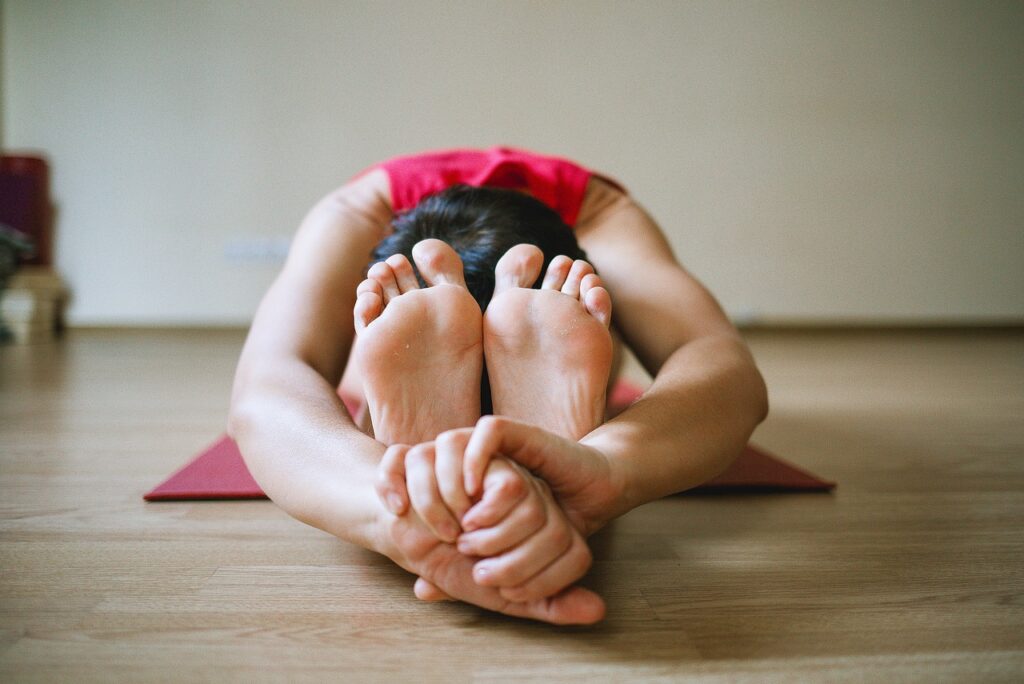Yoga is a delightful practice with countless benefits for both the mind and body. However, for beginners, it’s easy to fall into some common pitfalls that can hinder progress and lead to frustration. Fortunately, by becoming aware of these mistakes, you can navigate your yoga journey more smoothly. So, let’s explore some of the common blunders beginners make in yoga and how to avoid them.
Incorrect Alignment
Shoulder placement
One common mistake beginners make in yoga is incorrect shoulder placement. Proper shoulder alignment is essential for maintaining stability and preventing shoulder injuries. Beginners often have a tendency to round their shoulders forward or scrunch them up towards their ears, which can lead to strain and discomfort. To avoid this, focus on drawing your shoulder blades down and back, allowing your chest to open and your shoulders to relax.
Spine alignment
Another mistake beginners often make is improper spine alignment. During yoga poses, it’s important to maintain a neutral spine to prevent unnecessary stress on the back. This means avoiding rounding or overarching the spine. To achieve proper alignment, imagine a straight line running from the crown of your head to your tailbone, and engage your core muscles to support your spine throughout your practice.
Knee and ankle position
Improper knee and ankle position is also a common mistake among beginners. When practicing yoga poses that involve bending the knees, such as Warrior II or Chair pose, it’s important to ensure that the knees are aligned with the ankles and not collapsing inward. This can help prevent knee pain and injury. Additionally, pay attention to your ankle alignment, making sure they are stacked directly below your knees to maintain stability and promote proper weight distribution.
Overexertion and Pushing Too Hard
Pushing beyond limits
One of the most common mistakes beginners make in yoga is pushing beyond their limits. It’s important to remember that yoga is not a competition, and your practice should be tailored to your own body and abilities. Pushing yourself too hard can lead to injury and burnout. Listen to your body and modify or take breaks as needed. It’s better to practice with awareness and consistency rather than pushing yourself to the point of exhaustion.
Neglecting rest and recovery
In the pursuit of progress, beginners often neglect rest and recovery in their yoga practice. It’s important to give your body time to recover and rebuild after each session. Rest days are just as important as active practice days, as they allow your muscles and joints to heal and prevent overuse injuries. Incorporating restorative poses and relaxation techniques into your practice can also help promote relaxation and rejuvenation.
Ignoring pain or discomfort
Ignoring pain or discomfort is another mistake beginners make in yoga. While it’s normal to experience some level of discomfort or challenge in certain poses, it’s important to distinguish between discomfort and pain. Pain is your body’s way of signaling that something is wrong. If you experience sharp or intense pain during a pose, it’s crucial to back off or modify the pose to prevent injury. Listen to your body and honor its limitations to ensure a safe and sustainable yoga practice.

Straining the Neck
Craning the neck
Straining the neck is a common mistake beginners make, especially when practicing poses that involve looking upwards, such as Camel pose or Bridge pose. It’s important to keep the neck in a neutral position and avoid craning it to the point of discomfort. Instead, focus on lengthening the back of the neck and maintaining alignment with the rest of the spine. If necessary, use a prop, such as a folded blanket or a yoga block, to support your head and neck during these poses.
Incorrect head position in inversions
Inversions, such as Headstand or Shoulderstand, can be exciting for beginners, but they also pose a risk of straining the neck if not done correctly. Beginners may make the mistake of compressing the neck by sinking into the shoulders or cramming the crown of the head into the mat. To avoid this, focus on maintaining a long and relaxed neck while practicing inversions. Engage your core muscles and use the support of your arms to alleviate any strain on your neck.
Holding Breath
Forgetting to breathe
Forgetting to breathe is a mistake many beginners make in yoga. It’s easy to become so focused on getting into the correct pose that you forget to breathe deeply and rhythmically. Proper breathwork is an integral part of yoga practice, as it helps to calm the mind, increase oxygen flow, and enhance the body’s ability to relax. Remember to inhale and exhale deeply through your nose, allowing the breath to guide and support your movements.
Holding breath in challenging poses
Another common mistake is holding the breath during challenging poses. Holding the breath can create tension in the body, hinder the flow of energy, and prevent proper relaxation. Instead, focus on maintaining a steady and even breath throughout your practice, especially during challenging poses. By consciously breathing through these poses, you can cultivate a sense of calm and stability, allowing you to stay present and connected to your body.

Improper Wrist Alignment
Placing too much weight on the wrists
Improper wrist alignment is a mistake beginners often make in yoga, particularly in poses like Plank or Downward Facing Dog that place weight on the hands and wrists. Placing excessive weight on the wrists can lead to discomfort or even injury. To avoid this, distribute the weight evenly through your hands, engaging your whole hand, from the base of the palm to the fingertips. Additionally, ensure that the wrists are aligned with the shoulders and don’t collapse inward or outward.
Misaligning hands and fingers
Misaligning the hands and fingers is another common error. Beginners may unknowingly place their hands too wide or too narrow, causing unnecessary strain on the wrists and shoulders. To find proper alignment, position your hands shoulder-width apart and spread your fingers wide, distributing the weight evenly across all fingers, especially the index and middle fingers. This will provide stability and support for your wrists and promote correct alignment.
Lack of Focus on Core Activation
Insufficient engagement of core muscles
Many beginners overlook the importance of core activation in yoga. The core muscles, including the abdominals, obliques, and lower back, play a crucial role in providing stability and support during yoga poses. Neglecting to engage these muscles can lead to an unstable practice and put excess strain on other parts of the body. To strengthen your core and improve stability, focus on drawing your navel towards your spine and engaging your abdominal muscles in every pose.
Relying on extremities instead of core strength
Additionally, beginners often rely too heavily on their extremities, such as the arms and legs, instead of using their core strength. This can lead to unnecessary strain and fatigue in the limbs, as well as a lack of stability in the postures. Practicing yoga with a focus on core activation allows you to find stability from within, improving balance, control, and overall body awareness. Pay attention to engaging your core throughout your practice, and trust in its strength and support.

Skipping the Warm-up
Neglecting preparatory exercises
Skipping the warm-up is a common mistake made by beginners. Preparatory exercises, such as gentle stretches and joint mobilization, help warm up the body, prepare the muscles and joints, and reduce the risk of injury. By neglecting these exercises, beginners may jump straight into advanced poses without adequately preparing their bodies, increasing the likelihood of strain or injury. Take the time to warm up your body before each yoga practice, allowing for a safer and more effective experience.
Jumping into advanced poses without warming up
In their eagerness to progress, beginners may attempt advanced poses without warming up. This can put excessive strain on the muscles, ligaments, and joints, increasing the risk of injury. It’s important to remember that yoga is a journey, and progress should be gradual and mindful. Before attempting advanced poses, ensure that you have a solid foundation and an understanding of the necessary preparation and modifications. By acknowledging and respecting your current abilities, you can foster a safer and more sustainable practice.
Improper Modifications and Props Usage
Improper use of props
Props, such as blocks, straps, or blankets, can greatly enhance your yoga practice, especially as a beginner. However, improper use of props can be counterproductive and even detrimental to your practice. It’s important to learn how to utilize props correctly, as they can help you find proper alignment, provide support, and increase accessibility in certain poses. Seek guidance from an experienced teacher or utilize online resources to understand how props can assist you in achieving the full benefits of each pose.
Not modifying poses according to body limitations
Each body is unique, and it’s important to honor your own limitations and modify poses accordingly. Beginners often make the mistake of trying to replicate the exact form of a pose as they see it without considering their individual anatomy, flexibility, or strength. Failing to modify poses to suit your own body can lead to discomfort, strain, or injury. Instead, listen to your body and make necessary adjustments, such as using props, modifying the depth or intensity of a pose, or choosing alternative variations to accommodate your body’s needs.
Comparing and Competing
Comparing oneself to others
Comparing oneself to others is a common mistake beginners make in yoga. It’s natural to glance around the room and observe the abilities of your fellow practitioners, but constantly comparing yourself can lead to feelings of inadequacy, frustration, or even self-judgment. Remember that yoga is a personal journey, and everyone’s practice is unique. Focus on your own progress, celebrate your achievements, and cultivate self-compassion. Embrace the process rather than comparing yourself to others, and you’ll find more joy and fulfillment in your practice.
Competing with fellow practitioners
Similarly, competing with fellow practitioners is a mistake beginners often make. Yoga is not a competitive sport, and aiming to outperform others contradicts the essence of the practice. Yoga is about cultivating inner peace, self-awareness, and self-acceptance. Instead of striving to be better than others, shift your focus inward and concentrate on your own growth and intentions. Embrace the supportive and non-judgmental nature of the yoga community, and celebrate the progress and uniqueness of each individual on their own journey.
Lack of Patience and Consistency
Expecting quick results
Maintaining patience and consistency is key when practicing yoga, yet many beginners fall into the trap of expecting quick results. Yoga is a holistic practice that encompasses physical, mental, and spiritual aspects, and progress takes time. Instead of seeking immediate transformation or quick fixes, approach your practice with patience and a long-term perspective. View each session as an opportunity for growth and self-discovery, and trust that with consistent effort and dedication, positive changes will unfold gradually.
Skipping regular practice
Consistency is crucial for reaping the full benefits of yoga, yet beginners often make the mistake of skipping regular practice. Life can get busy, and it can be tempting to prioritize other obligations over yoga. However, by making yoga a consistent part of your routine, you establish a strong foundation and allow for greater progress. Aim for a realistic and sustainable practice schedule, whether it’s a daily routine or a few sessions per week. By committing to yourself and your practice, you create the space for growth, self-care, and overall well-being.
In conclusion, beginners in yoga often make various mistakes that can hinder their progress or lead to injury. It’s important to pay attention to proper alignment, listen to your body, and practice with patience and consistency. By addressing these common mistakes and cultivating awareness, you can enhance your yoga journey, promote a safe and sustainable practice, and experience the many physical, mental, and spiritual benefits that yoga has to offer. Remember, yoga is a personal endeavor, and embracing your individuality and unique path will enrich your practice in countless ways.

